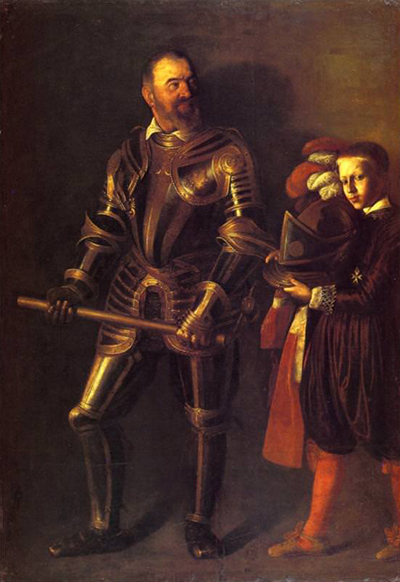This oil on canvas stems from a time of great upheaval towards the very end of the artist's life.
Following Caravaggio's escape from Naples on murder charges in 1607, the Portrait of Alof de Wignacourt and his Page was painted during the artist's time on Malta, shortly before his return to Naples via Sicily, and eventual death on the way to Rome in 1610.
The chief subject, Alof de Wignacourt, was a rising star of the Order of the Knights of Saint John, and by 1601, had been elected Grand Master. Keen to enhance the reputation of the Order in its post-siege capital of Valetta, he would have been delighted to entertain Caravaggio at the height of his fame.
Alof de Wignacourt, along with the most senior knights of the Order, would have been amongst the very first subjects painted by Caravaggio on his arrival in Malta, and was completed in 1607 or 1608.
Alof himself is pictured at his pinnacle, at around sixty years of age, having completed far-reaching improvements on the island including fortifications and a new aqueduct. The page boy appears as a nod to other princely courts of the time, and indeed, the subject had by now turned the Order into a sovereign force in the image of the great contemporary powers.
The boy himself has been identified as Nicholas de Paris Boissy by art historian John Gash, and is pictured here before a long, illustrious career culminating in his becoming the Grand Prior of France in 1657.
Notably, he is as thoughtfully captured as the protagonist himself, drawing the eye as much to his young, winsome grin as to his master's confident smile.
Indeed, the painting of master and boy together would have been unusual at the time, making his appearance on the canvas all the more remarkable in this case. Almost foregrounded and bathed in a golden light, he perhaps challenges his senior as the most sympathetic and human figure in this particular work.
Critics have pointed out the slight awkwardness of the boy's pose, appearing from the upper body to be standing in front of de Wignacourt, while his feet are in line with the older subject.
This has been explained as an artifact of the artist's process, whereby the models would not have been present together in the studio at the same time, but rather have attended separately.
The Portrait of Alof de Wignacourt and his Page now hangs in the Louvre, Paris.




